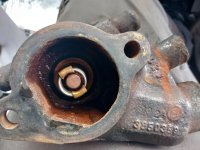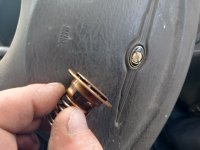Salt away will (or is supposed to) dissolve salt and calcium deposits, that may loosen some rust flakes, but once cast iron starts rusting, it is going to keep doing that which is why that stuck open thermostat is more or less a chronic problem we all have in salt water. I though of other safer ways to flush the engine, one being more involved, it might go like this:
remove the front circulating pump and fab up a fitting that fits over the inlet in the block that will accept a garden hose and another fitting that is closed for the other side. Then I'd take a spare thermostat housing with no stat in it and install it in place of the regular one. Take the big hose and install it on the end of the stat housing. Then with the garden hose connected to one side, and the other side blocked off gently fill the block till the water runs clear out of the big hose, you can also remove the block drains to flush that lower block area as well. Then reverse the process, flush from the other side of the block. This will not damage gaskets, but will get as much of the rust flakes out of the block as you can. Might be a good thing to do every other season. Now I have to wrap my head around making up a couple of adapters out of PVC pipe etc to see if it can be done. I'd probably used a couple of small block Chevy water pump gaskets as a template. This method would flush the block using water flow that is the same when the engine is running, on the small block Chevrolets, water enters on both sides of the front of the block, flows around the cylinders, then up through the cyl heads, then forward to the cross over in the intake manifold and out through the stat housing.
You're in rivers, right, so you are in fresh water, I wonder if your boat was used in salt/brackish water before you got it?
I think over time especially if you fill with a good PG antifreeze with corrosion inhibitors, you might see a reduction in this issue. For me, it is an every 3-4 seasons thing, not all the time. Don't want to jinx it though lol.
The filter idea might work but I wouldn't want to use it with a load on the engine, maybe at home on the water hose.























